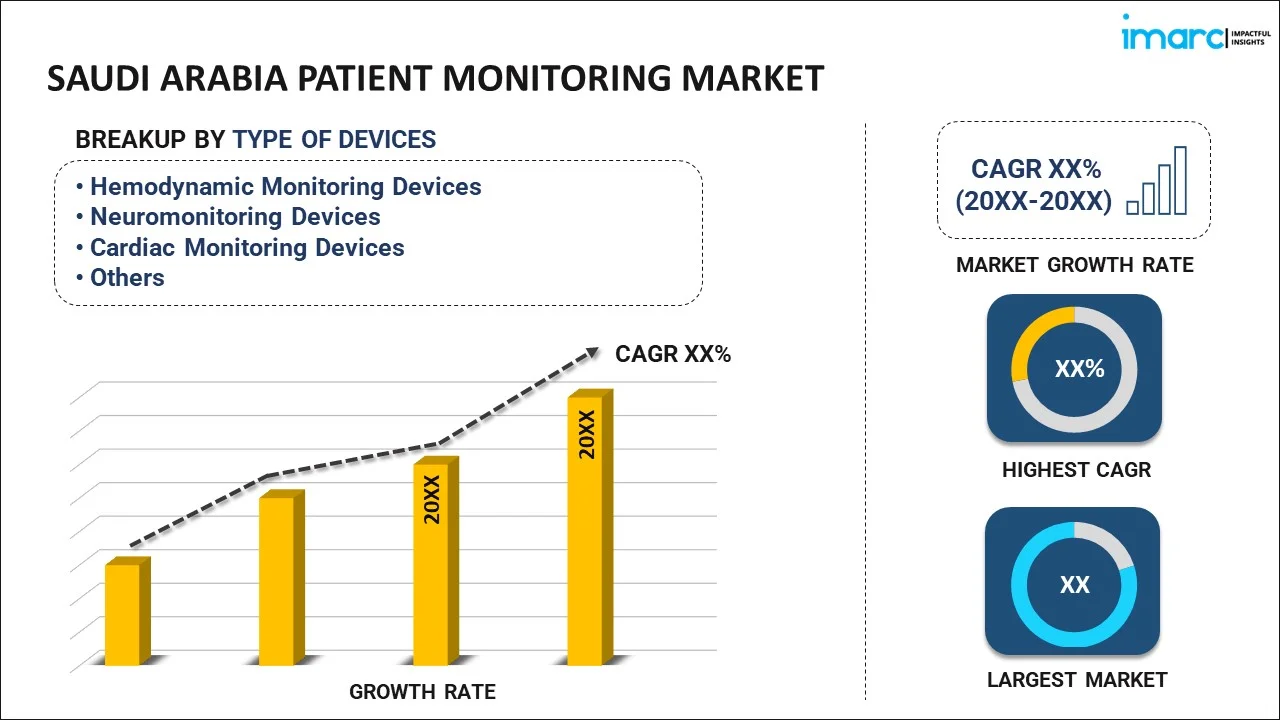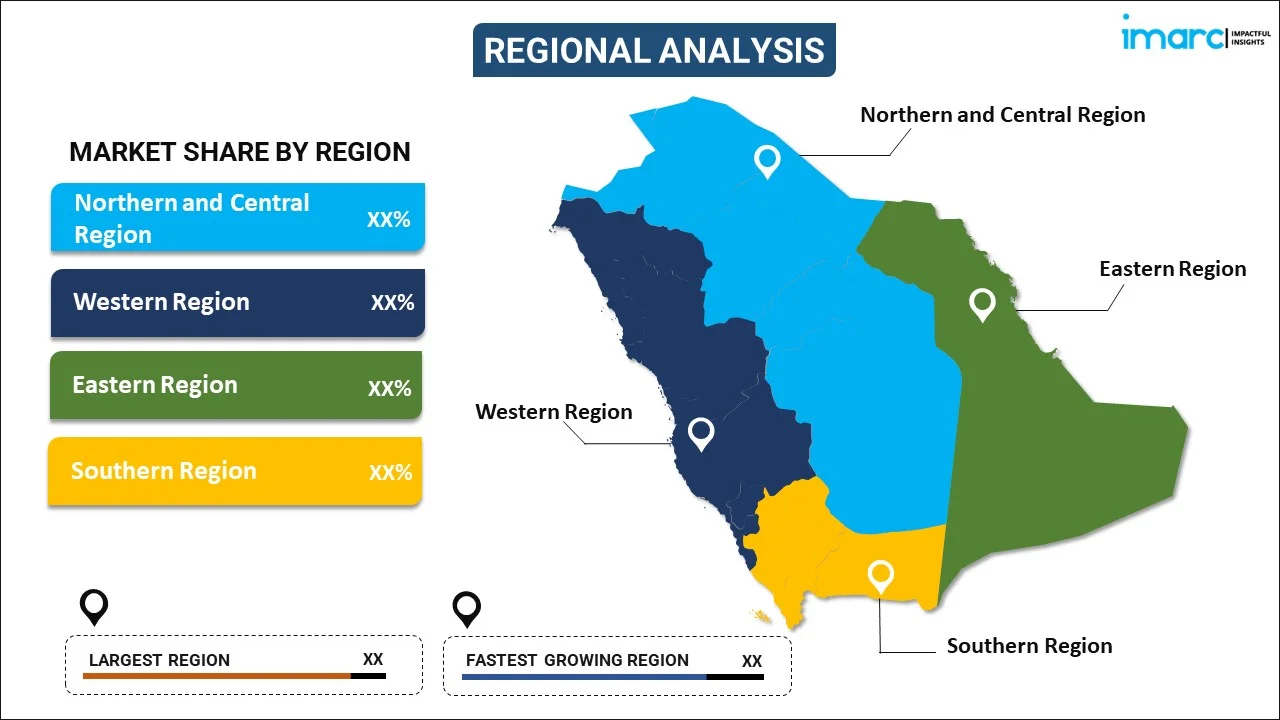
Saudi Arabia Patient Monitoring Market Report by Type of Device (Hemodynamic Monitoring Devices, Neuromonitoring Devices, Cardiac Monitoring Devices, Respiratory Monitoring Devices, Remote Monitoring Devices, and Others), Application (Cardiology, Neurology, Respiratory, Fetal and Neonatal, Weight Management and Fitness Monitoring, and Others), End User(Home Healthcare, Hospitals, and Others), and Region 2025-2033
Market Overview:
Saudi Arabia patient monitoring market size reached USD 450 Million in 2024. Looking forward, IMARC Group expects the market to reach USD 753 Million by 2033, exhibiting a growth rate (CAGR) of 5.88% during 2025-2033. The increasing adoption of telemedicine, as it enables healthcare providers to monitor patients' vital signs and health conditions remotely, enhancing accessibility, and reducing the need for in-person visits is primarily driving the market growth.
|
Report Attribute
|
Key Statistics
|
|---|---|
|
Base Year
|
2024 |
|
Forecast Years
|
2025-2033
|
|
Historical Years
|
2019-2024
|
| Market Size in 2024 | USD 450 Million |
| Market Forecast in 2033 | USD 753 Million |
| Market Growth Rate (2025-2033) | 5.88% |
Patient monitoring is a crucial component of modern healthcare, involving the continuous or periodic observation and measurement of a patient's vital signs, physiological parameters, and medical data to assess their health status and well-being. This process typically employs a range of medical devices and technologies, such as electrocardiograms (ECGs), blood pressure monitors, pulse oximeters, and telemetry systems, to track variables like heart rate, blood pressure, oxygen levels, and more. The collected information provides healthcare professionals with real-time data and trends, enabling them to make informed decisions about a patient's care. Patient monitoring plays a critical role in various clinical settings, including hospitals, intensive care units, emergency rooms, and even remote telehealth environments, helping to detect and respond to medical issues promptly, optimize treatment plans, and improve patient outcomes.
Saudi Arabia Patient Monitoring Market Trends:
The patient monitoring market in Saudi Arabia is a rapidly evolving and essential segment within the country's healthcare industry. With a growing emphasis on quality healthcare services and the adoption of advanced medical technologies, patient monitoring solutions have gained prominence. Additionally, the market encompasses a wide range of devices and systems, including vital sign monitors, continuous telemetry systems, ECG machines, and wearable health trackers. These technologies are employed across various healthcare settings, including hospitals, clinics, and home care, to monitor patients' vital signs, track chronic conditions, and ensure timely interventions. Moreover, the rise of telemedicine and remote patient monitoring solutions has further accelerated the demand for patient monitoring devices, allowing for real-time monitoring and data sharing between patients and healthcare providers. As Saudi Arabia continues to invest in its healthcare infrastructure and digital health initiatives, the patient monitoring market is poised for sustained growth, offering opportunities for both local and international healthcare technology providers to contribute to the nation's evolving healthcare landscape.
Saudi Arabia Patient Monitoring Market Segmentation:
IMARC Group provides an analysis of the key trends in each segment of the market, along with forecasts at the country level for 2025-2033. Our report has categorized the market based on type of device, application, and end user.
Type of Device Insights:

- Hemodynamic Monitoring Devices
- Neuromonitoring Devices
- Cardiac Monitoring Devices
- Respiratory Monitoring Devices
- Remote Monitoring Devices
- Others
The report has provided a detailed breakup and analysis of the market based on the type of device. This includes hemodynamic monitoring devices, neuromonitoring devices, cardiac monitoring devices, respiratory monitoring devices, remote monitoring devices, and others.
Application Insights:
- Cardiology
- Neurology
- Respiratory
- Fetal and Neonatal
- Weight Management and Fitness Monitoring
- Others
A detailed breakup and analysis of the market based on the application have also been provided in the report. This includes cardiology, neurology, respiratory, fetal and neonatal, weight management and fitness monitoring, and others.
End User Insights:
- Home Healthcare
- Hospitals
- Others
The report has provided a detailed breakup and analysis of the market based on the end user. This includes home healthcare, hospitals, and others.
Regional Insights:

- Northern and Central Region
- Western Region
- Eastern Region
- Southern Region
The report has also provided a comprehensive analysis of all the major regional markets, which include Northern and Central Region, Western Region, Eastern Region, and Southern Region.
Competitive Landscape:
The market research report has also provided a comprehensive analysis of the competitive landscape in the market. Competitive analysis such as market structure, key player positioning, top winning strategies, competitive dashboard, and company evaluation quadrant has been covered in the report. Also, detailed profiles of all major companies have been provided.
Saudi Arabia Patient Monitoring Market Report Coverage:
| Report Features | Details |
|---|---|
| Base Year of the Analysis | 2024 |
| Historical Period | 2019-2024 |
| Forecast Period | 2025-2033 |
| Units | Million USD |
| Scope of the Report | Exploration of Historical Trends and Market Outlook, Industry Catalysts and Challenges, Segment-Wise Historical and Future Market Assessment:
|
| Type of Devices Covered | Hemodynamic Monitoring Devices, Neuromonitoring Devices, Cardiac Monitoring Devices, Respiratory Monitoring Devices, Remote Monitoring Devices, Others |
| Applications Covered | Cardiology, Neurology, Respiratory, Fetal and Neonatal, Weight Management and Fitness Monitoring, Others |
| End Users Covered | Home Healthcare, Hospitals, Others |
| Regions Covered | Northern and Central Region, Western Region, Eastern Region, Southern Region |
| Customization Scope | 10% Free Customization |
| Post-Sale Analyst Support | 10-12 Weeks |
| Delivery Format | PDF and Excel through Email (We can also provide the editable version of the report in PPT/Word format on special request) |
Key Questions Answered in This Report:
- How has the Saudi Arabia patient monitoring market performed so far and how will it perform in the coming years?
- What has been the impact of COVID-19 on the Saudi Arabia patient monitoring market?
- What is the breakup of the Saudi Arabia patient monitoring market on the basis of type of device?
- What is the breakup of the Saudi Arabia patient monitoring market on the basis of application?
- What is the breakup of the Saudi Arabia patient monitoring market on the basis of end user?
- What are the various stages in the value chain of the Saudi Arabia patient monitoring market?
- What are the key driving factors and challenges in the Saudi Arabia patient monitoring?
- What is the structure of the Saudi Arabia patient monitoring market and who are the key players?
- What is the degree of competition in the Saudi Arabia patient monitoring market?
Key Benefits for Stakeholders:
- IMARC’s industry report offers a comprehensive quantitative analysis of various market segments, historical and current market trends, market forecasts, and dynamics of the Saudi Arabia patient monitoring market from 2019-2033.
- The research report provides the latest information on the market drivers, challenges, and opportunities in the Saudi Arabia patient monitoring market.
- Porter's five forces analysis assist stakeholders in assessing the impact of new entrants, competitive rivalry, supplier power, buyer power, and the threat of substitution. It helps stakeholders to analyze the level of competition within the Saudi Arabia patient monitoring industry and its attractiveness.
- Competitive landscape allows stakeholders to understand their competitive environment and provides an insight into the current positions of key players in the market.
Need more help?
- Speak to our experienced analysts for insights on the current market scenarios.
- Include additional segments and countries to customize the report as per your requirement.
- Gain an unparalleled competitive advantage in your domain by understanding how to utilize the report and positively impacting your operations and revenue.
- For further assistance, please connect with our analysts.
 Inquire Before Buying
Inquire Before Buying
 Speak to an Analyst
Speak to an Analyst
 Request Brochure
Request Brochure
 Request Customization
Request Customization




.webp)




.webp)












